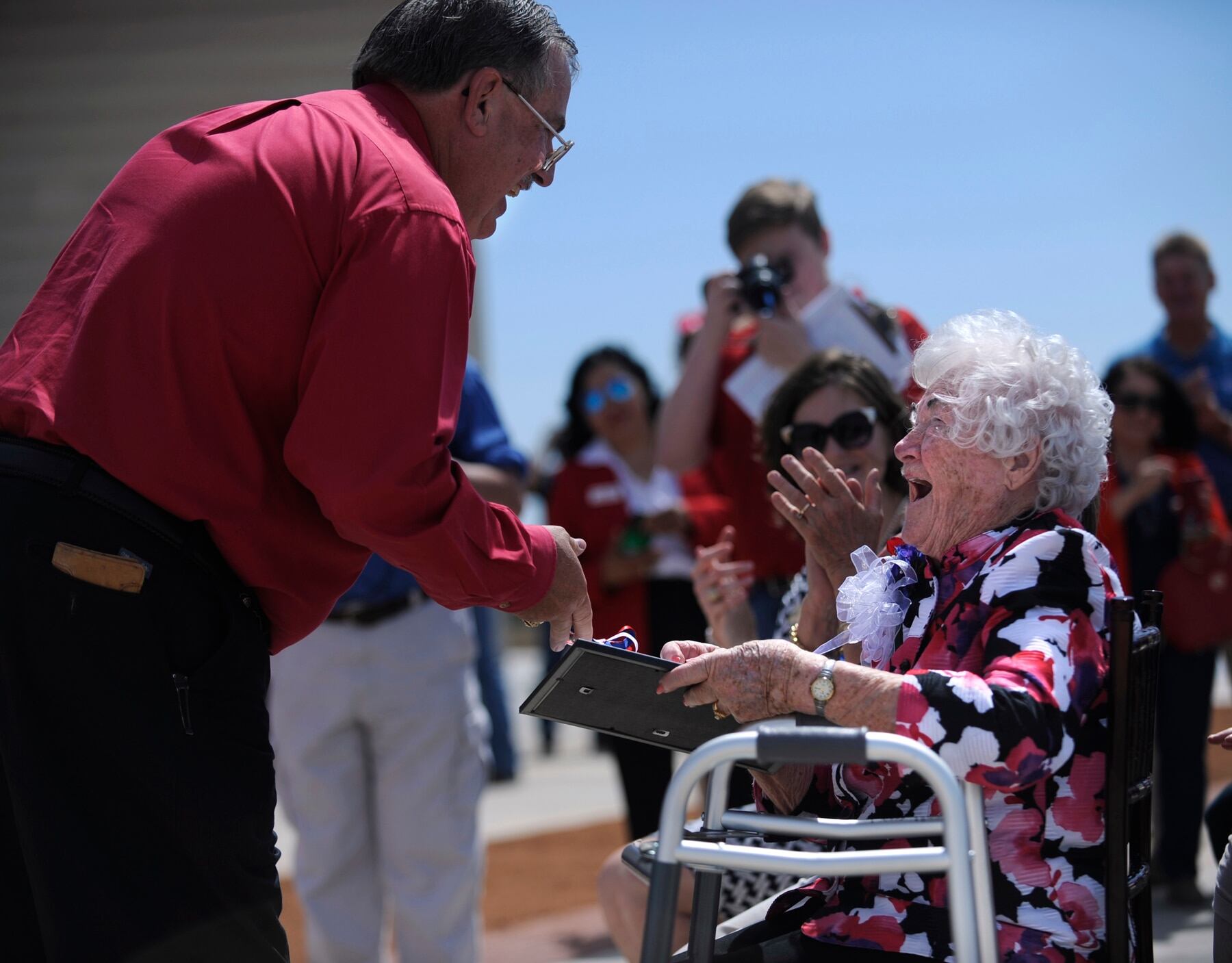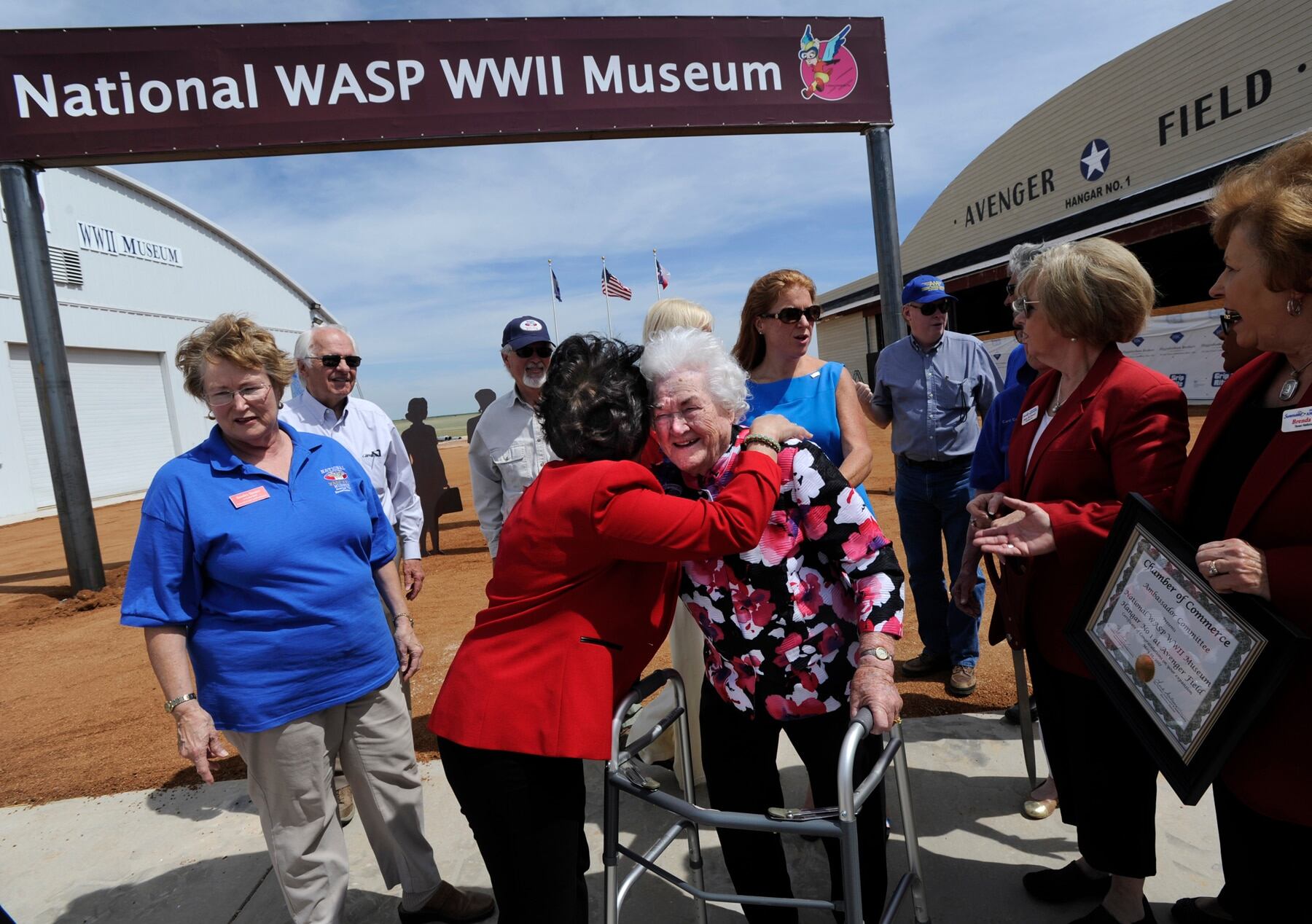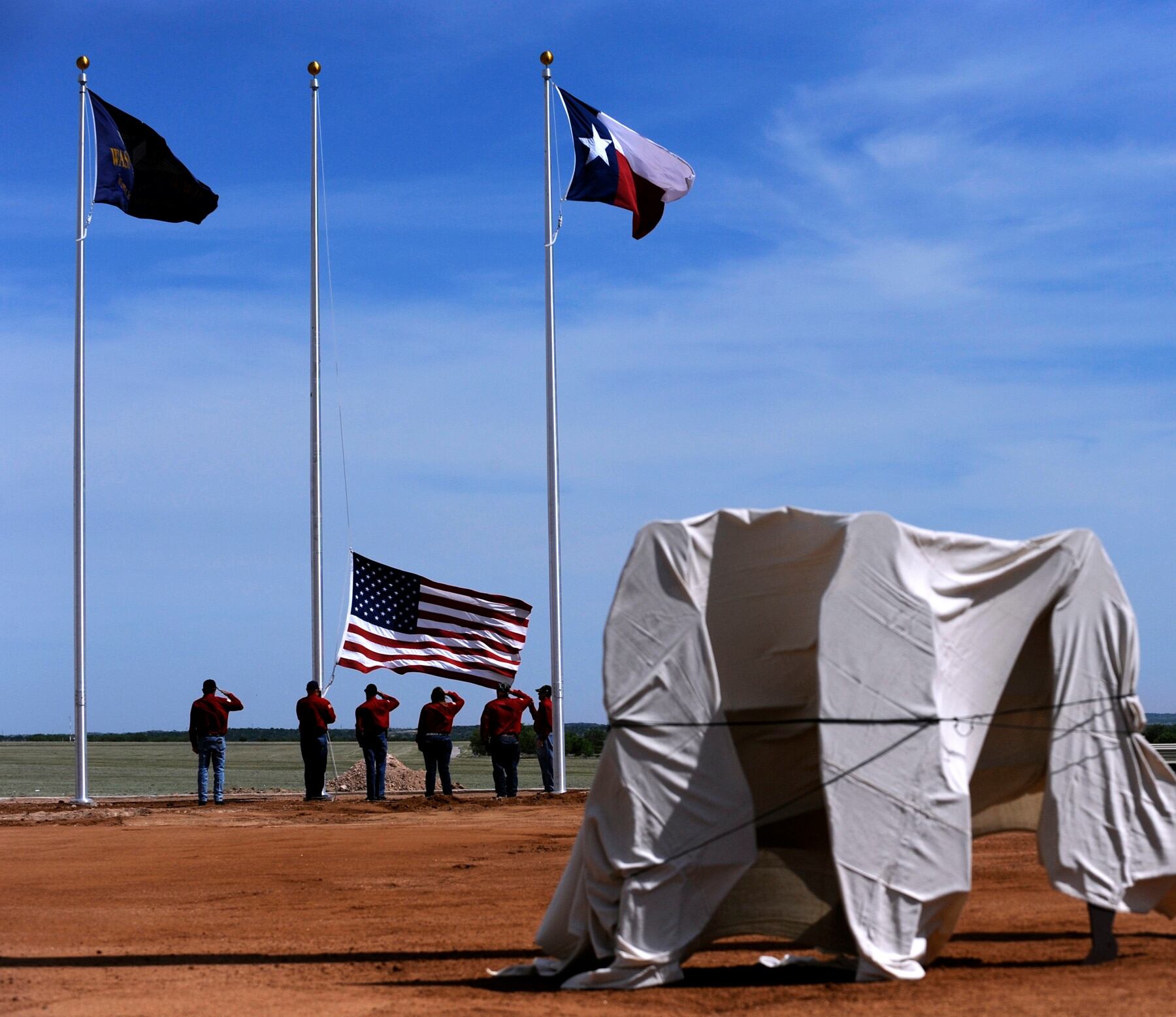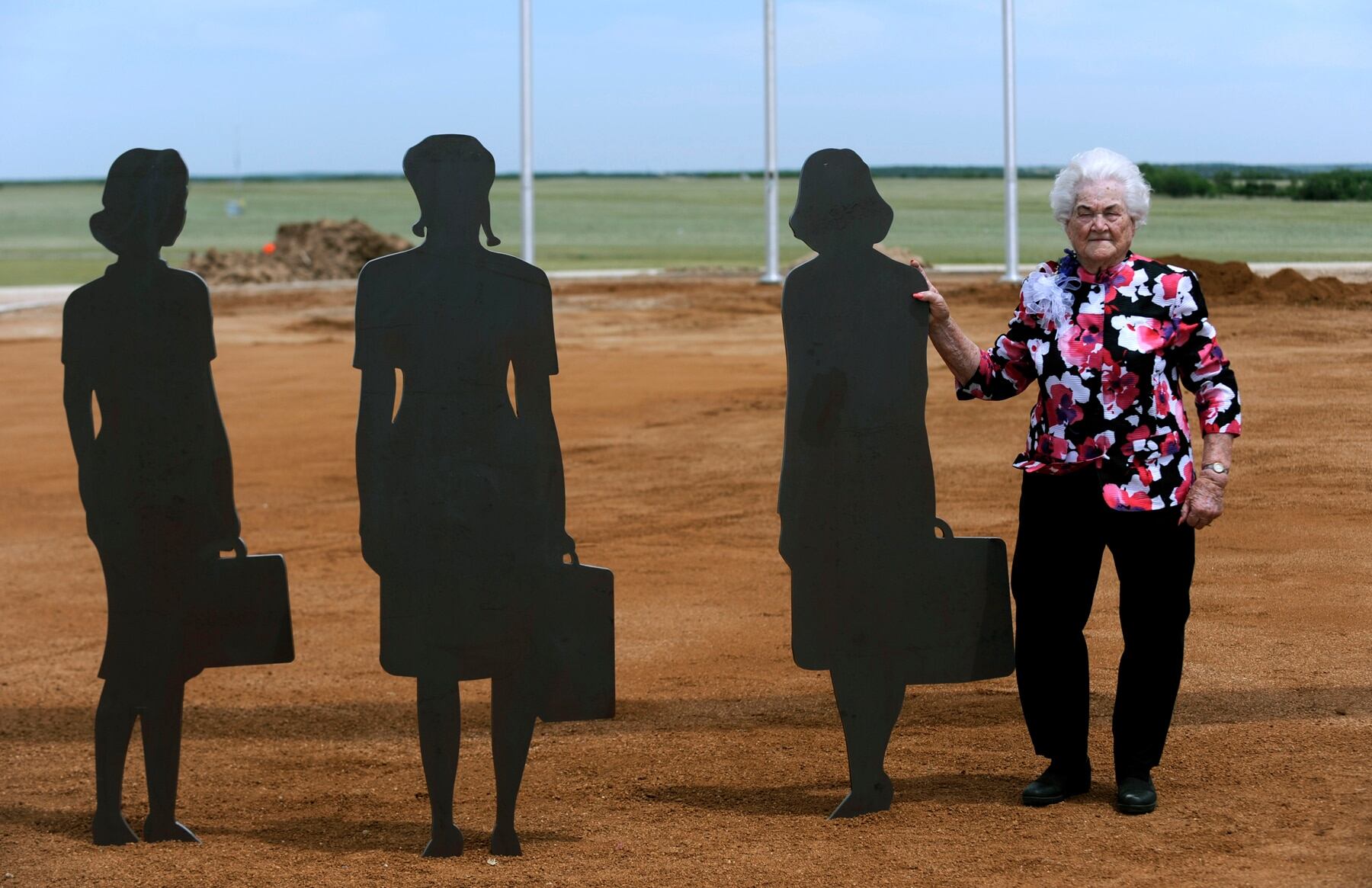SWEETWATER, Texas — The "gigglin' little redhead" was all smiles.
The Abilene Reporter-News reports as the guest of honor, Jessie Lou McReynolds deserved more than just the key to the city. In its place, Sweetwater Mayor Jim McKenzie handed the former airplane mechanic a glittering, stainless-steel wrench.
At 95 years-old, McReynolds' red locks have long since changed to silver. But that hair and a bubbly disposition earned her an affectionate nickname during the two years she spent fixing airplanes for the Women Airforce Service Pilots.
The National WASP World War II Museum reached a milestone in late May with dedication of the recreated Hangar No. 1 at Avenger Field. It completes Phase I for the campus.

Jessie Lou McReynolds reacts as Sweetwater, Texas, Mayor Jim McKenzie presents her with a stainless steel wrench Thursday, May 25, 2017, during the dedication of Hangar No. 1 at Avenger Field.
Photo Credit: Ronald W. Erdrich/The Abilene Reporter-News via AP
Ann Hobing, the museum's executive director, said recreating Hangar No. 1 had been a conversation ever since the museum opened in 2005. The original hangar burned in the 1950s.
"Today we have what we are calling 'A Dream Realized,'" Hobing said. "We have had board members and donors and volunteers over the course of years planning and designing and fundraising, to get this to happen."
David Zobrist is the architect for the new building. It sits on the east side of the old municipal hangar that's been used as the museum up to this time.
"We matched the proportions of this building to that one," Zobrist said. A small plaza separates the two, both for aesthetic reasons and in adherence to fire codes.
"The old building will become strictly an airplane museum," he said. "Airplanes that fly will be stored in there. That's why the buildings are pulled apart."

Jessie Lou McReynolds is hugged by Jeanne Brewer after the dedication and ribbon-cutting of the new Hangar No. 1 at Sweetwater's Avenger Field Thursday, May 25, 2017. The building is a replica of the original hangar which trained the Womens Airforce Service Pilots during World War II and is part of the National WASP World War II Museum. McReynolds, 95, was a mechanic at the school.
Photo Credit: Ronald W. Erdrich/The Abilene Reporter-News via AP
The plaza features an homage to the base's original gate. Beneath and slightly behind the elevated sign are three steel cutouts of women. The figures are based on a historical photograph.
"This was the ladies when they just arrived, you can imagine them in their dresses and heels, with their suitcases on a dusty road," Zobrist said of the silhouettes. "We recreated that as our gateway entry to the museum."
The new building, while resembling a hangar from the outside, will be more of a traditional museum and event center within. Standing exhibits in the older building will be moved in here, and new exhibits will be created for the space as well.
The gift shop, administrative offices, and archive room will also be in this new building.
"The beauty of having this space and having it air-conditioned is it keeps our archives within reach and more accessible," Hobing said. "Like most museums, most of the collections and artifacts are in storage, so having this space we will allow us to refresh exhibits overtime."
She added that some of the older exhibits will be getting a face-lift in the new space and that they hope to incorporate more high-tech displays which highlight the role of science and engineering in aviation.
"Of course the heritage here at Avenger Field and West Texas and the history of the WASP program, is really core to our mission," she said.

An honor guard salutes as the American flag is raised during the dedications ceremony for Hangar No. 1 at Avenger Field in Sweetwater, Texas, Thursday May 25, 2017.
Photo Credit: Ronald W. Erdrich/The Abilene Reporter-News via AP
The WASPs held their annual homecoming this weekend, inviting former members, their families and others to celebrate their legacy. With that event complete, the museum will embark upon Phase II of their plan, to realize all the uses for their new building.
"A lot of what we've done here is restraint; it's to not over-build before we know what to really build," said Gerald Driemeier, the museum's creative director. "We are going to spend some time thinking about how the interior will fit out."
For a museum honoring aviation, it's fair to say some parts of its completion are still up in the air. No one can put an exact time down for when the entire thing will be done.
"It's all driven by funding, if we were to double the budget we have right now we could complete it," Zobrist said. "But in what time? We won't know that until we know what funding we have."
Part of the new space will feature a Donor Wall and Zobrist explained why.
"(It's) an opportunity for people to see that they do make a difference and that they are recognized," he said. "So from homecoming on forward, we will be doing a fundraising campaign."
He called this a special project for him.
"Out of all the projects that I've done, and I've been in this business for 30-plus years, this is one of the coolest for what it means," he said. "My mother-in-law was a WASP, so it's personal to me and her ashes are out here."

In this Thursday, May 25, 2017, photo, Jessie Lou McReynolds stands beside the steel silhouettes at the National WASP World War II Museum plaza, in Sweetwater, Texas.
Photo Credit: Ronald W. Erdrich/The Abilene Reporter-News via AP
Betty Jo (Streff) Reed died in 2013 at 90. A typical WASP, Zobrist said she moved herself from Phoenix to Sweetwater when she was 75.
"I met her in El Paso to drive her the rest of the way," he recalled. "We talked 12 hours about the WASPs, and that's how I got hooked."
During the war, the WASPs were used to doing it their way and they made sure everyone who worked with them was just as serious about it.
"I really felt honored that they asked a little farm girl to take over and do an important job like that," McReynolds said.
She'd grown up on a farm as a self-described tomboy. Just like the pilots, with all the men off to war it made sense to find women who knew their way around an engine and how to fix one. McReynolds fit that bill.
"They had us fly, to make us realize the importance of our work," she continued. "I did it several times; one time they flew us all around, over the city and did flips and what have you.
"I just loved it. I wasn't scared at all."
Did she laugh the whole time?
"Probably. Because I was known as the 'giggling little redhead'," she said, chuckling. "I was ready to go again!"




